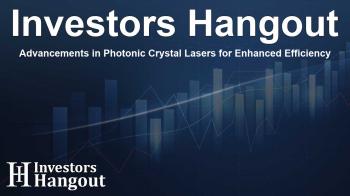Advancements in Photonic Crystal Lasers for Enhanced Efficiency

Transforming the Future of Laser Technology
Innovative research conducted by dedicated scientists has led to significant mathematical advancements in the study of photonic crystal surfaces. These developments present a leap towards constructing more efficient laser devices. Laser diodes, which are essential elements in modern optical applications, traditionally generate and amplify light through repeated reflection or optical feedback. Once a desired optical gain is achieved, these diodes emit highly focused laser beams for various practical uses.
Exploring Photonic Crystal Surface-Emitting Lasers
Among the notable advancements are photonic crystal surface-emitting lasers (PCSELs). These sophisticated laser diodes enhance the traditional laser configuration by employing a unique optical structure. Unlike conventional lasers, PCSELs separate the gain, feedback, and emission functions, resulting in scalable single-mode power and innovative designs that accommodate a variety of applications.
Numerical Simulation of Light Wave Interactions
Recently, researchers published their findings in a reputable journal, detailing their novel method of numerically simulating the interaction of light waves within these advanced laser systems. Their exploration focused on triangular-lattice PCSELs, where the photonic crystal creates a triangular grid structure. Notably, the results indicated that light wave coupling in this configuration surpassed that of square lattice PCSELs, leading to improved optical feedback vital for efficient lasing processes.
The Role of Numerical Simulations
In conducting their research, the team examined six plane light waves spread throughout the crystal, using a technique known as Bragg diffraction for coupling. Through their numerical simulations, they compared the 2D coupling in triangular-lattice PCSELs against the square lattice counterparts—culminating in insightful revelations regarding the effectiveness of their designs.
Key Analytical Findings for Laser Development
Furthermore, the researchers derived analytical equations for mode frequencies and coupling constants, paving the way for optimizing the design of transverse magnetic (TM) triangular-lattice PCSELs. As stated by Professor Stephen John Sweeney, a senior member of the IEEE, these equations markedly enhance in-plane 2D coupling for TM-mode triangular lattice PCSELs. This enhancement is particularly crucial for devices that operate under low-index contrast conditions.
New Insights into Lasing Mechanisms
Moreover, the research team laid down the general form of coupled wave equations applicable to the unit cells comprising the crystal lattice. This theoretical foundation is essential for designing PCSELs aimed at delivering superior efficiency. They also illuminated the 'fundamental lasing mode' present in triangular-lattice PCSELs, recognizing it as the electromagnetic field pattern that yields the most effective laser output.
Connecting Theoretical Models to Practical Applications
The comparative analysis between TM and transverse electric (TE) polarizations became apparent through their findings, highlighting TM modes' decisive advantages in specific configurations, particularly in low index contrast scenarios. By establishing these relationships, the derived analytical models form a cornerstone for experimental optimization of photonic crystal structures.
The team's ongoing work promises to deliver crucial enhancements in both device efficiency and performance, heralding an era of optimized laser technologies that can cater to the evolving demands in various industrial sectors.
Frequently Asked Questions
What are photonic crystal lasers?
Photonic crystal lasers are advanced laser diodes that leverage photonic crystals for improved light generation and amplification, maximizing efficiency and scalability.
How do triangular-lattice PCSELs compare to square lattice PCSELs?
Triangular-lattice PCSELs demonstrate stronger light wave coupling and enhanced optical feedback, making them more efficient than square lattice counterparts.
What role does Bragg diffraction play in laser efficiency?
Bragg diffraction aids in coupling light waves within lasers, significantly enhancing the performance and output quality of photonic crystal lasers.
What is the significance of mode frequencies and coupling constants?
Mode frequencies and coupling constants are critical parameters that inform the design of laser systems, contributing to their overall efficiency and functionality.
How can these findings impact future laser designs?
The research lays a foundational understanding for optimizing photonic crystal lasers, facilitating advancements that enhance both device performance and energy efficiency.
About The Author
Contact Caleb Price privately here. Or send an email with ATTN: Caleb Price as the subject to contact@investorshangout.com.
About Investors Hangout
Investors Hangout is a leading online stock forum for financial discussion and learning, offering a wide range of free tools and resources. It draws in traders of all levels, who exchange market knowledge, investigate trading tactics, and keep an eye on industry developments in real time. Featuring financial articles, stock message boards, quotes, charts, company profiles, and live news updates. Through cooperative learning and a wealth of informational resources, it helps users from novices creating their first portfolios to experts honing their techniques. Join Investors Hangout today: https://investorshangout.com/
The content of this article is based on factual, publicly available information and does not represent legal, financial, or investment advice. Investors Hangout does not offer financial advice, and the author is not a licensed financial advisor. Consult a qualified advisor before making any financial or investment decisions based on this article. This article should not be considered advice to purchase, sell, or hold any securities or other investments. If any of the material provided here is inaccurate, please contact us for corrections.

